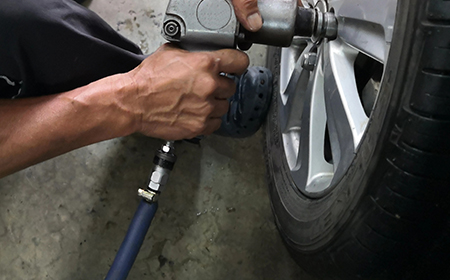The inner structure of pneumatic tires and the way the tire is assembled is quite complex. A tire has a combination of rubber, steel, fabric and adhesives that are all vulcanized together to ensure durability and long tread-life. Very occasionally some part of the tire manufacturing process can go wrong. The result could be a bulge on the side of your tire. If the bulge is evident when the tire is first installed and inflated, then the cause is likely related to a manufacturing defect.
This type of defect could be caused by production equipment falling out of specification just enough for the plies of the tires to not perfectly align under the rubber. When inflated, the bulge will show in the weakest part of the tire, in this case, the part of the tire where the reinforcing casing plies under the rubber are thin, or non-existent. If the bulge on the side of the tire is elongated, at a 90-degree angle to the top of the wheel, then this is likely the cause. The condition is usually first recognized by the technician installing your tire, however a bulge related to a manufacturing defect could become increasingly apparent with usage. If you detect a bulge in your tire, it is a warrantable condition. You should return to your vehicle service provider or tire installer for an inspection, and potentially a no-charge replacement tire per the manufacturer's warranty policy.
More commonly, a bulge in the sidewall of your tire is related to an impact with a pothole or other road hazard. A hard impact can cause “pinch shock”. This is when the sidewall of the tire is severely compressed between the object and rim of your wheel. The the inner cords of the fabric ply are squeezed together and can break. The spot where the break occurred no longer has the reinforcement of the under-lying plies, and the tire will bulge out. Most tire installers will be able to tell if the bulge is the result of a severe impact vs a manufacturer's defect. The flange of the wheel will be damaged, or there will be marks on the rubber showing that the sidewall rubber was in contact with the wheel. The impact may not have been severe enough to break the rubber, but if left on the vehicle, the bulge will eventually rupture.
Remember to do a visual inspection of your tires occasionally. In addition to looking at the tread for excessive or irregular wear, you should check the sidewall for bulges. Any sign of a bulge warrants a trip to your nearest service station to assess the severity of the bulge and the likely cause. If the cause of the bulge was a road hazard impact within one year of purchase on Tires-easy.com, you may be eligible for a no-charge replacement. Please see the Road Hazard Policy for details.
